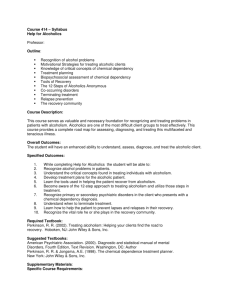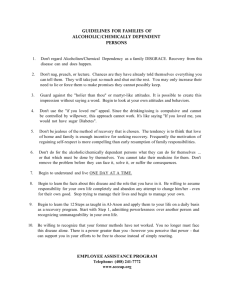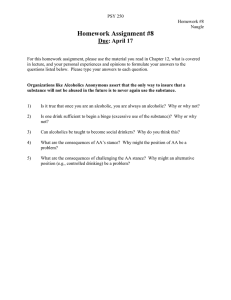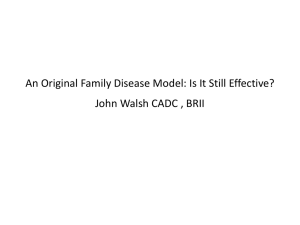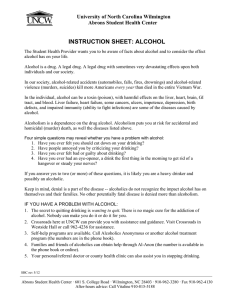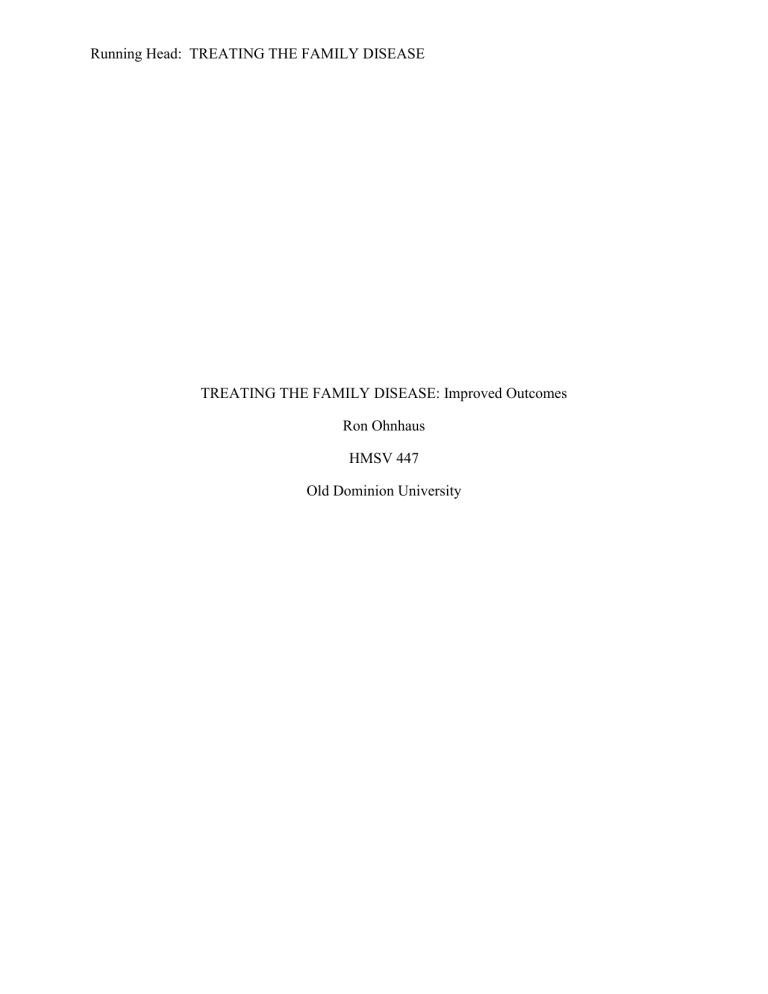
Running Head: TREATING THE FAMILY DISEASE TREATING THE FAMILY DISEASE: Improved Outcomes Ron Ohnhaus HMSV 447 Old Dominion University 1 TREATING THE FAMILY Overview Does one bad apple spoil the barrel, as an ancient proverb suggests? Science answers “Yes.” Apples emit a gas that promotes ripening, which causes apples in proximity to spoil more rapidly than they would apart from one another (Soniak, 2014). Social science studies show the bad apple metaphor applies to groups of four to eight people, known as the “one-bad-apple effect” (Kerr et al., 2008, p. 604, 610; Bruce, 2013). Based on the aforementioned studies, if the bad apple were analogous to an alcoholic or drug addict and the group was his or her family, all immediate family members might be expected to suffer illness due to just one member’s alcoholism/addiction. Assuming that all family members become ill by association with one addict/alcoholic member suggests that all family members would benefit from treatment. This paper attempts to show the association that exists between individuals with substance use disorders (SUD’s), their families, and evidence-based; and to evaluate the efficacy of whole family treatment as compared to treating only the addicted member. For the purposes of this paper, the terms “alcoholic,” “addict,” “chemically dependent,” “substance abuse/r,” “alcohol or drug dependence” (AODD), “chronic illness,” and “chronic disease” are used loosely and somewhat interchangeably to identify the person or illness associated with “substance use disorder” (SUD), as described by the Diagnostic and Statistical Manual of Mental Disorders: DSM-5, published in May of 2013. The DSM-5 defines an SUD by two or more of eleven criteria being present in the assessment of an individual (American Psychiatric Association, 2013). It is not the intent of this paper to enter into debate or controversy about whether alcoholism or addiction to other drugs is properly classified as a “disease.” The validity of the points raised herein does not depend on a precise distinction between any of these terms. 2 TREATING THE FAMILY The Family Disease Concept The U.S. government’s National Institute of Health (NIH)/National Institute on Drug Abuse (NIDA) tells those seeking help for substance abuse disorders that “Like other chronic diseases, addiction can be managed successfully” and that “Like many diseases, it can take several attempts at treatment to find the right approach” (NIDA, 2014, p. FAQ). The NIDA website urges family members and friends of addicts/alcoholics to “assure them that you will support them in their courageous effort [to overcome addiction]” (2014). NIDA states "Involvement of a family member or significant other in an individual's treatment program can strengthen and extend treatment benefits." The combination of these statements indicate that recovery from substance abuse will be enhanced by the support and involvement of the family, yet examination of the NIDA website offers little in terms of specific ways to support and be involved in the treatment process. The site mentions just one resource for friends and families when it says, “Support groups for family members of people with addictions, like Al-anon and Alateen, can also be helpful” (NIDA, 2014, p. FAQ). Al-Anon Family Groups (AFG) originated in the early days of Alcoholics Anonymous when spouses of alcoholics became acquainted and realized that they had been affected by living with an alcoholic, and that they needed help to recover from the “devastating effects of alcoholism” (Al-Anon, 1997, p. xi-xii). The basic text of Alcoholics Anonymous, first published in 1939 contains the following statement made by a physician: “Years of living with an alcoholic is almost sure to make any wife or child neurotic. The entire family is, to some extent, ill” (Alcoholics Anonymous, 2001, p. 122). AFG states that “alcoholism is an enormously powerful family disease” that can cause family members to “feel trapped in an endless tunnel of suffering” accompanied by an extreme sense of aloneness (Al-Anon, 1990, p. 1). In their primary volume, TREATING THE FAMILY 3 AFG says that, “Everyone in an alcoholic relationship – friends, co-workers, family members, as well as the alcoholic – plays a part in the dynamics of the disease” (Al-Anon, 2008, p. 27), and that unless recovery is undertaken by the non-addicted individuals, “the dynamics of the disease will continue to dominate [those] relationships” (2008, p. 27). The current Chair of the American Society of Addictive Medicine Workgroup on Family and Generational Issues, Dr. Joseph Troncale, M.D., makes three points in his endorsement of Al-Anon: 1. The whole family needs “recovery from the brokenness that is typical of alcoholism." 2. When the whole family enters recovery, the addicted person's odds of success in sobriety are improved. 3. When a family member of an alcoholic chooses not to get help for their association with alcoholism, they “continue a pattern” of adverse behavior (2014, p. Professional Perspectives). Current research consistently affirms the family disease in a number of ways. A study comparing other chronic illnesses with alcoholism indicates that alcoholism produces an effect in a family similar to that caused by diabetes and asthma – all three illnesses increase the frequency of health problems and cost of health care of the non-addicted family members (Ray, Mertens & Weisner, 2009). This effect was most pronounced in the alcoholic family. A key question posed by the study is whether the negative effect on the health of the non-addicted family members would be eliminated concurrent with successful treatment of the alcoholic member (2009, p.213). If Troncale’s proposition is correct, then one would conclude that successful treatment of the alcoholic member alone would not correct health problems of the other family members. Using the bad apple analogy, removing the bad apple from the barrel might seem like a way to TREATING THE FAMILY 4 prevent spoiling the remaining apples, but in all likelihood, by the time the spoilage becomes visible, advanced ripening of the other apples has already taken place, and removing the visibly spoiled apple does not reverse this effect, although its removal may slow down the progression of the problem among the apples that are left. Like the apple barrel, the SUD affected family harbors illness among its members albeit not always visible to casual observation. While research is not conclusive on this matter, experiential evidence indicates that the successful treatment of the alcoholic/addict alone does not cure the associated illnesses of the non-addicted members, who often continue to “react to alcoholic patterns of behavior” even if they “haven’t been associated with an alcoholic in many years” (Al-Anon, 2008, p.29). Such patterns of behavior could even appear in subsequent generations through learned behavior or as a result of epigenetic transmission (Vassoler & Sadri-Vakili, 2014). While still in its infancy, the field of epigenetics may provide the answers to many perplexing questions involving learned and inherited behaviors. Vassoler, Byrnes and Pierce (2014) reviewed studies related to the preconception effects of drug exposure to adolescent humans and animals on the subsequent generation. Alcohol, nicotine, cocaine, morphine and marijuana were the subject drugs of the test. The review included only studies where conception occurred after several weeks of being drug-free, so as not to allow prenatal exposure to the drugs, and to avoid in-utero exposure of drugs to the fetus. The results showed several adverse effects in the offspring, including increased anxiety, depression, developmental abnormalities, impaired memory, attention disorder, and decreased learning capabilities. This transmission of behavioral and physiological problems to parent’s offspring may be a partial factor in explaining why some SUD families exhibit additional health problems in spite of the parent’s successful status in recovery. 5 TREATING THE FAMILY Treatment Outcomes There are many current studies comparing the results of SUD treatment modalities, represented by six articles considered in the following summary review. These articles provide a cross section of geography, culture, gender, age, methodologies and substances in their assessment of individual SUD treatment as compared to treatment involving the entire family. A study to examine the cost of treating SUD’s with individual versus family therapy found that family therapy cost less than individual treatment for SUD and the recidivism rates were lower (Morgan, Crane, Moore & Eggett, 2013). This result applied to all age groups of SUD diagnosed individuals. Schaub et al. (2014) showed that Multidimensional Family Therapy (MDFT) “outperformed individual therapy” in treating adolescents with cannabis use disorder, and “showed promise as a treatment for…substance use disorders” (p. 3). Danzer (2014) makes a strong case for the use of MDFT in treatment of adolescent SUD, citing a personal case that exemplified results predicted by studies of this evidence-based method. Danzer cites research showing MDFT’s effectiveness in treating severe adolescent SUD including favorable reductions in negative behaviors and improvements in co-occurring psychiatric problems (p. 18). Because MDFT involves working directly with the parents on the issues that they bring to the family dynamic of SUD in the adolescent, they can change for the better and these changes contribute significantly to the overall family outcome. Danzer’s blowby-blow account of his use of MDFT with an adolescent and his parents vividly demonstrates the theoretical principles of this model of family-based therapy. Klostermann and O'Farrel (2013) point to a body of professional literature that overwhelmingly shows family-based SUD treatment superior to individual treatment, and they review the three dominant theoretical models of family SUD treatment – the family disease 6 TREATING THE FAMILY approach, the family systems perspective, and behavioral models (p. 236). All three models target substance abuse as the undesirable element in the family system, and each stress the need for abstinence through improved family dynamics that nurture caring and open relationships between all family members. The differences in theoretical models are mostly found in varying degrees of emphasis on formal therapy sessions and self-help group attendance, yet all three include both of these elements. The treatment models based on these theoretical approaches include MDFT, Behavioral Couples Therapy (BCT), Community Reinforcement and Family Training (CRAFT), Unilateral Family Therapy (UFT), Multisystemic Family Therapy (MFT), Solution-Focused Therapy (SFT), and Brief Strategic Family Therapy (BSFT). These treatment models all show improved outcomes when compared to individual therapies in terms of longer periods of abstinence, reduced recidivism, less divorce/separation and more satisfying family relationships (Klostermann & O’Farrel, 2013). O’Farrel and Clements (2012) explore controlled studies of marital and family therapy (MFT) when used in cases of SUD. They find that MFT helps the non-addicted family members cope better, even if the alcoholic/addict continues their substance abuse, and that CRAFT “promotes treatment entry” more effectively than other methods including Al-Anon referral (p.122). They also report that BCT is “clearly more effective than individual treatment at increasing abstinence and improving relationship functioning” (p. 122). Their extensive review also shows that BCT works well for women, gay and lesbian alcoholics and that it has been efficacious in reducing intimate partner violence (IPV) among couples exhibiting SUD. Conclusions Steinglass (2009) reports that in spite of the overwhelming evidence that family therapies offer substantially superior outcomes in all aspects of SUD treatment, there remains a dearth of TREATING THE FAMILY 7 family-based programs available to SUD-affected individuals. Barriers to family-based programs include difficulties scheduling all family members for sessions, resistance of nonaddicted members to get help for themselves, and a lack of trained professionals to administer family therapies (Klostermann & O’Farrel, 2013). Steinglass proposes a Motivational Interviewing approach as a bridge between the “divide currently separating the worlds of family therapy and substance abuse treatment” (p. 171). All recently reviewed studies agree that a holistic treatment of the family yields a superior outcome to individual treatment. In addition to the obvious benefits of abstinence, the non-addicted family members experience improved mental and physical health – an outcome that is reflected by the experiential evidence of AFG: Alcoholism is a progressive disease that can be arrested but not cured. Therefore, we who are affected by another’s alcoholism can best ensure our own continuing serenity if we learn to depend on ourselves for our own well-being, rather than on another person’s sobriety. As we become increasingly aware of our behavior, our choices, and the part we play or have played in the alcoholic situation, we become much better able to make changes that allow us to create a life we can be proud to live (Al-Anon, 2008, p. 34). AFG recommends mental health and substance abuse counseling for families in addition to participation in self-help groups (2008). Treatment outcomes for those that embrace the family disease concept and utilize family-based therapies are enviable. SUD treatment models should move toward family-based therapy quickly to maximize successful outcomes of all involved parties. 8 TREATING THE FAMILY References Al-Anon Family Group Headquarters, Inc. (1990). --In all our affairs: Making crises work for you. New York, NY: Al-Anon Family Group Headquarters. Al-Anon Family Group Headquarters, Inc. (1997). Paths to recovery: Al-Anon's steps, traditions, and concepts. Virginia Beach, VA: Al-Anon Family Groups. Al-Anon Family Group Headquarters, Inc. (2008). How Al-Anon works for families & friends of alcoholics. New York: Al-Anon Family Groups. Alcoholics Anonymous. (2001). Alcoholics Anonymous: The story of how many thousands of men and women have recovered from alcoholism (4th ed.). New York: Alcoholics Anonymous World Services. American Psychiatric Association. (2013).Diagnostic and statistical manual of mental disorders: DSM-5. Retrieved from http://www.bu.edu/aodhealth/issues/issue_sept13/rastegar_dsm5.html Bruce, E. (2013, March 27). One Bad Apple Spoils The Whole Barrel « Historically Speaking. Retrieved from http://idiomation.wordpress.com/2013/03/27/one-bad-apple-spoils-thewhole-barrel/ Danzer, G. (2014). Multidimensional Family Therapy in Theory and in Practice. Child & Youth Services, 35(1), 16-34. doi:10.1080/0145935X.2014.893742 Henry, M. (1997). Matthew Henry's concise commentary on the whole Bible. Retrieved from http://biblehub.com/commentaries/genesis/9-21.htm Kerr, N. L., Rumble, A. C., Park, E. S., Ouwerkerk, J. W., Parks, C. D., Gallucci, M., & Van Lange, P. M. (2009). “How many bad apples does it take to spoil the whole barrel?: Social exclusion and toleration for bad apples.” Journal Of Experimental Social Psychology, 45(4), 603-613. doi:10.1016/j.jesp.2009.02.017 TREATING THE FAMILY Klostermann, K., & O'Farrell, T. (2013). Treating substance abuse: partner and family approaches. Social Work In Public Health, 28(3-4), 234-247. doi:10.1080/19371918.2013.759014 Morgan, T. B., Crane, D., Moore, A. M., & Eggett, D. L. (2013). The cost of treating substance use disorders: individual versus family therapy. Journal Of Family Therapy, 35(1), 2-23. doi:10.1111/j.1467-6427.2012.00589.x O’Farrell, T. J. and Clements, K. (2012), Review of Outcome Research on Marital and Family Therapy in Treatment for Alcoholism. Journal of Marital and Family Therapy, 38: 122– 144. doi: 10.1111/j.1752-0606.2011.00242.x Ray, G., Mertens, J. R., & Weisner, C. (2009). Family members of people with alcohol or drug dependence: Health problems and medical cost compared to family members of people with diabetes and asthma. Addiction, 104(2), 203-214. doi:10.1111/j.13600443.2008.02447.x Schaub, M. P., Henderson, C. E., Pelc, I., Tossmann, P., Phan, O., Hendriks, V., & ... Rigter, H. (2014). Multidimensional family therapy decreases the rate of externalising behavioural disorder symptoms in cannabis abusing adolescents: outcomes of the INCANT trial. BMC Psychiatry, 14(1), 1-16. doi:10.1186/1471-244X-14-26 Soniak, M. (2014, August 7). Does One Bad Apple Really Spoil the Whole Bunch? | Mental Floss. Retrieved from http://mentalfloss.com/article/31666/does-one-bad-apple-reallyspoil-whole-bunch Steinglass, P. (2009). Systemic-motivational therapy for substance abuse disorders: an integrative model. Journal Of Family Therapy, 31(2), 155-174. doi:10.1111/j.14676427.2009.00460.x 9 TREATING THE FAMILY 10 Troncale, J. (2014). Welcome to Al-Anon Family Groups. Retrieved from http://www.alanon.alateen.org/professional-perspectives/item/289-treatment-must-include-the-familynot-just-the-alcoholic Vassoler, F. M., Byrnes, E. M., & Pierce, R. C. (2014). Invited review: The impact of exposure to addictive drugs on future generations: Physiological and behavioral effects. Neuropharmacology, 76(Part B), 269-275. doi:10.1016/j.neuropharm.2013.06.016 Vassoler, F., & Sadri-Vakili, G. (2014). Mechanisms of transgenerational inheritance of addictive-like behaviors. Neuroscience, 264198-206. doi:10.1016/j.neuroscience.2013.07.064
